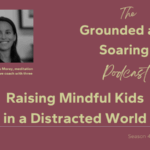Here’s my version of the story most GenXers and older tell about their pre-smartphone childhoods: I spent my after-school and summer hours pedaling, unhelmeted, through the wilds of Southern California suburbia with my twin brother. Our days were a blend of exploration and a (usually) healthy dose of mischief.
We’d play catch in the middle of the street, scooting to the curb when cars sped past. We’d climb down the narrow canyon beyond our backyard for no other reason than to see what was down there. We’d end up scraped and sunburned. If we stumbled upon a rattlesnake, we made sure not to tell our parents.
That freedom, that unstructured sprawl of play, seems like a relic now. It had its real dangers, but having lived through or despite them, it’s tempting to feel nostalgic because those dangers feel somehow less pervasive and potent than those of today – maybe because they were more concrete.
When they were young, I didn’t necessarily want my own kids playing that way, but I also lamented that they missed some of the benefits.
My wife and I attempted to shield our two daughters, now 20 and 24, from the digital deluge of the early aughts the best we could. But we also let them roam a bit — albeit with more helmets and more padding. Yes, they had scheduled activities — soccer, ballet, lacrosse — but they also had a tree-lined street in Cleveland Heights, Ohio, close-by neighbors whose houses they ran to on their own, and a bakery they could walk to for evening bread or Sunday morning cinnamon rolls.
Even in the decade or so since their little girl days, today’s state of play feels different. And why wouldn’t it be? Everything is different.
Everything, with one exception perhaps: the natural tendencies of human beings to explore our surroundings, to discover new things, to seek community, to test our abilities, and to find joy in adventures and camaraderie.
The Changing Play Landscape
There are logical reasons for this shift, but there are also new dangers, less visible than a rattlesnake but maybe more poisonous: fractured communities inspire more curated and coordinated activities; digital connection can both entice kids to stay indoors and inspire well-intentioned parental surveillance; gun violence at the mall makes all of us leery of unstructured wanderings.
The anxieties are real, but the most effective response isn’t necessarily more structure and control. In fact, research by psychologist Peter Gray suggests the opposite: unstructured play is a vital ingredient for raising happy, well-adjusted children.
In a recent interview with the Harvard Graduate School of Education, he notes: “We are so overprotecting children, because we are so always there to solve their problems for them [that] they’re not developing the sense that they can solve their own problems.”
He links the decline of kids taking the reins of their lives directly to the surge in mental health challenges – from anxiety to apathy, codependence to low self-worth.
Suddenly, my nostalgic rambles don’t just seem like old man tales; they’re a testament to a vital need that’s too often unmet in today’s childhoods.
Independent Play: The Unsung Hero
Gray isn’t just waxing poetic about the good old days. He’s armed with data, decades of it, underscoring how the erosion of play correlates with the rise of anxious, unhappy kids.
“Independent play provides all kinds of things for children,” he explains:
..if we’re going to talk about the role of independent play and children’s mental health, there are two things, two fundamental categories of things that it provides. First of all, independent play immediately is what makes children happy….Children are designed to play… And what play is is this activity that’s initiated and directed by children away from adults. And we almost don’t allow that to happen anymore except online.
…The other reason that play promotes mental health is play and other independent activities, where children are doing things on their own. Not being protected and directed, supervised by adults, is where children learn how to take charge of their own lives. It’s where they learn how to solve problems. It’s where they learn how to make friends.
At Marin Montessori School, we’re on a mission to keep the spirit of play alive and kicking. That spirit is woven into the fabric of our pedagogy and culture. Step onto either campus, and you’ll see independent play emerging naturally.
One spot where you’ll see it in particularly bright colors: Our Additional School Care (ASC) program, which doesn’t just echo Montessori principles; it embodies Gray’s belief that “children are designed to learn in play.”
Gray points to a societal overcorrection towards safety and structure as a prime villain in the saga of the disappearing playtime. Our ASC program is our polite rebellion against this narrative, providing a space where kids can rediscover play on their own terms.
“When the environment has been properly prepared with the characteristics of the child in mind,” notes Matt Stratton, MMS’ Elementary Movement and Director of Additional School Programs, “creativity and sense of purpose blossom. At ASC we take great care to prepare the environment to support this sense of care-free freedom. The children are at ease in the space, and through that ease, unstructured play abounds. We play games, dance, explore our imagination, and express our inner artists. ”
Central to the approach: Freedom with adult support. Taz Pesso, Primary Additional School Care Coordinator, compares the program to “a cul-de-sac where children play safe and free with neighbors checking on them from their kitchen windows.”
Unstructured play in a curated, prepared environment gives children the opportunity to “develop what psychologists call an internal locus of control,” Gray explains, “which is an internal sense that I’m competent to take charge of my life. Something can happen to me, and it’s not a disaster. I can take care of it.”
When I think about my own childhood, I can absolutely point to specific moments when I had to navigate treacherous waters (not always metaphorical ones either) and, in the aftermath, took note of my own growing competence. I see it in my daughters who have their own stories of independence and self-sufficiency to tell.
Looking out my office window at the ASC kids darting around, I see flashes of those moments while the adults observe and choose wisely when to step in and when to stay back.
Looking Forward Through the Rearview Mirror
The journey from the unbridled freedom of my childhood to the regimented schedules of today’s kids is more than just generational evolution. It’s the understandable response to a world that feels both increasingly isolating and surveilled. When the stakes feel so high and the dangers so real, of course parents feel compelled to step in.
But maybe the evolution can be paused. Maybe we can look hard at our impulse to protect and take note of that impulse’s implications.
Peter Gray’s advocacy for independent play is a roadmap back to a world where kids can explore, fall, get up, and grow on their own terms. Or, as MMS’ Matt Stratton puts it: “Unstructured playtime is the messy first draft of life’s grand adventure.”

Terry is the Director of Communications and Strategic Initiatives at Marin Montessori School. A classroom teacher for 30 years, he manages Grounded and Soaring.





